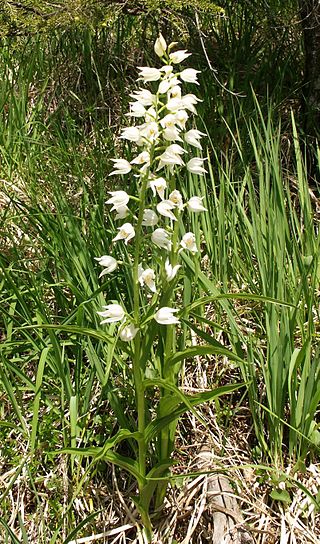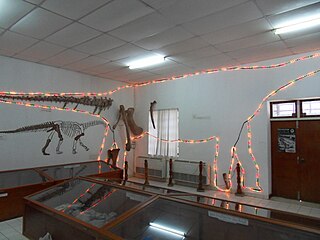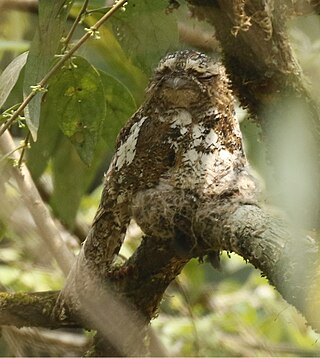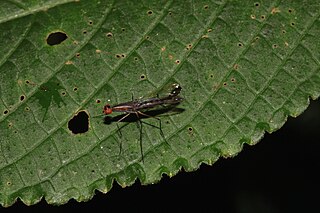
The Laotian rock rat or kha-nyou, sometimes called the "rat-squirrel", is a species of rodent found in the Khammouan region of Laos. The species was first described in a 2005 article by Paulina Jenkins and coauthors, who considered the animal to be so distinct from all living rodents, they placed it in a new family, Laonastidae. It is in the monotypic genus Laonastes.

Titanosaurus is a dubious genus of sauropod dinosaurs, first described by Richard Lydekker in 1877. It is known from the Maastrichtian Lameta Formation of India.

The Mandschurosaurus are an extinct genus of hadrosaurids based on material from the Late Cretaceous of China and possibly also the Early Cretaceous of Laos. It was the first dinosaur genus named from China, and a mounted skeleton based on the holotype of M. amurensis is on display at the Central Geological and Prospecting Museum in St. Petersburg; however, much of the skeleton is plaster.

Cephalanthera, abbreviated Ceph in horticultural trade, is a genus of mostly terrestrial orchids. Members of this genus have rhizomes rather than tubers. About 15 species are currently recognized, most of them native to Europe and Asia. The only species found in the wild in North America is Cephalanthera austiniae, the phantom orchid or snow orchid. Ecologically, this species is partially myco-heterotrophic. Some of the Eurasian species hybridise.

Tangvayosaurus is a genus of sauropod dinosaur from the Aptian-Albian age Lower Cretaceous Gres superieurs Formation of Savannakhet Province, Laos. It was a basal somphospondylan, about 15 m long, and is known from the remains of two or three individuals.

Daphniphyllum is the sole genus in the flowering plant family Daphniphyllaceae and was described as a genus in 1826. The genus includes evergreen shrubs and trees mainly native to east and southeast Asia, but also found in the Indian Subcontinent and New Guinea.

Owston's palm civet is a civet native to Vietnam, Laos and southern China. It is listed as Endangered by IUCN because of an ongoing population decline, estimated to be more than 50% over the last three generations, inferred from over-exploitation, habitat destruction and degradation.

Hodgson's frogmouth is a species of bird in the family Podargidae. It is found in Bangladesh, Bhutan, China, India, Laos, Myanmar, Thailand, and Vietnam. Its natural habitat is temperate forests.

The rusty-naped pitta is a species of bird in the family Pittidae.

The big-headed turtle is a species of turtle in the family Platysternidae from Southeast Asia and southern China.

Sacalia is a genus of turtles in the family Geoemydidae. The genus was erected by John Edward Gray in 1870. The Sacalia is native to Southereastern China, Laos, and Vietnam. It was declared an endangered species of turtle by the IUCN Red List due to its illegal trade. The sacalia has a carapace of dark-brown color that permits it to camouflage to its habitat. They are believed to select the area of a river that better matches their color.

The particolored flying squirrel is a species of rodent in the family Sciuridae. It is found in Bangladesh, Bhutan, Cambodia, China, India, Laos, Myanmar, Nepal, Thailand, and Vietnam. Its natural habitat is subtropical or tropical dry forests. It is threatened by habitat loss.

The giant huntsman spider is a species of the huntsman spider family Sparassidae found in Laos. It is considered the world's largest spider by leg span, which can reach up to 30 cm (1 ft).

The bronze featherback is a ray-finned fish in the family Notopteridae found in South and Southeast Asia. Although primarily found in fresh water, it has been known to enter brackish water. At present, it is the only member of the genus Notopterus, but as currently defined, it is likely a species complex.

Malayemys is a genus of turtles in the family Geoemydidae. It was considered monotypic until 2005 It is found in several countries of Southeast Asia.

The Nemacheilidae, or stone loaches, are a family of cypriniform fishes that inhabit stream environments, mostly in Eurasia, with one genus, Afronemacheilus found in Africa. The family includes about 790 species.

The family Nothybidae contains only the genus Nothybus, a group of colorful and elongated flies. The family has been recently revised.

The Phou Khao Khouay leaf-nosed bat is a species of bat found in Laos and Vietnam. It was described as a new species in 2006. It is considered vulnerable to extinction by the IUCN.

The long-toothed pipistrelle is a species of bat of the genus Hypsugo. It is a small bat, with a length of 35.2–38.4 mm of forearm, and 5.9–7 mm of foot. It feeds on insects and has especially long canines compared to others of its genus.

Counillonia is an extinct genus of dicynodont therapsid from the area of Luang Prabang in Laos, Southeast Asia that lived at around the time of the Permian-Triassic boundary and possibly dates to the earliest Early Triassic. Its type and only known species is C. superoculis. Counillonia was related to the Triassic dicynodonts such as Lystrosaurus and the Kannemeyeriiformes that survived the Permian mass extinction, but it was more closely related to the Permian genus Dicynodon than to either of these lineages. Counillonia may then possibly represent another line of dicynodonts that survived the Permian mass extinction into the Triassic period, depending on its age. The discovery of Counillonia in Laos and its unexpected evolutionary relationships hint at the less well understood geographies of dicynodont diversity across the Permo-Triassic boundary outside of well explored regions like the Karoo Basin in South Africa.




















